Hot Topics in Tech with Jon Riley: Blog Series Menu
In the ever-evolving ecosystem of information architecture and UX design frameworks, one thing remains constant, the balance one must strike between user needs and organizational requirements.
When I was in graduate school at the University of Michigan, I took a wonderful course with Dan Klyn of the Understand Group focused on information architecture. This course pushed us toward managing the newly created complexity that digital space has borne, where user needs, business goals, and macro level strategy often conflict at multiple strata of organizations. One of their methods, which we will discuss today, wrangles the relative newness of this complexity through a structured, yet adaptive strategy called in/tension modeling. You’ll learn how this tool helps bring clarity and purpose to your organization in designing their digital and physical experiences, meeting user expectations as well as business needs with respect for all voices in the room.
This blog post explores what in/tension modeling is, how it works, and how you can use it to design experiences in your organization.
For a more detailed breakdown of in/tension modeling, check out this post by TUG written by the aforementioned Dan Klyn.
Hot Topics in Tech (Part 5): Consensus Building Using In/Tension Modeling
What is In/Tension Modeling?
In/tension modeling is framing and management of tensions within a larger design or organizational system. Multiple stakeholders, audiences, and financial drivers may have competing interests that tug and pull on one another. Instead of ignoring the voices in the room that don’t have decision-making power, in/tension modeling brings them forward where they can be heard and discussed, seeking some type of consensus and satisfactory result.
The very term “in/tension” is a play on words:
- “In tension” highlights the natural conflicts or trade-offs inherent in any system.
- “Intention” emphasizes the importance of making decisions with purpose and clarity.
These two aspects-balanced tension modeling-serves to help the organization move toward solutions that are both realistic and aspirational.
How Does the In/Tension Model Work?
In/tension modeling generally consists of three steps:
1. Observation
One should begin by observing the major forces in one’s system. These could involve:
- User Needs: These are what the constituent or user expects, wants, and/or needs from the topic or focus.
- Business Objectives: What are the organization’s goals, perhaps financial health, organization visibility, or donor relations?
- Contextual Factors: What are the internal or external drivers that impact the topic, such as technology limitations, legal bindings, and budget?
2. Mapping
Once one has identified the core elements, this is followed by mapping tensions between them, usually entailing:
- Plotting the competing forces along a continuum (for example: cost-efficiency in tension with a quality user experience).
- Highlight where there are likely to be trade-offs or friction.
- Understand how these tensions impact your stakeholders and business outcomes.
3. Alignment and Consensus
The final stage is alignment through reframing of the tension, which may be achieved by:
- Establishing direct and specific priorities toward resolving competing objectives.
- Exploring solutions that address tensions simultaneously.
- Creating a common vision for the project, organization, or strategy moving forward.
Applications of In/Tension Modeling
1. Digital Transformation Projects
Competition of demands-in/tension-underpins the very basis of digital transformation for organizations, such as updating systems with continuity of service.
2. Information Architecture Design
In tension modeling, the need of the user for navigation is pitted against the business priorities for content when structuring information in a website, app, or other digital medium.
3. Service design and customer experience
In/tension modeling is invaluable in service design to balance customer and employee needs with those of the operational efficiencies.
4. Organizational Strategy
Beyond design, it lends itself to very high-level decisions on organizational positioning, funding strategy, or complexity.
Example: In/Tension Modeling in Practice
Imagine a nonprofit organization redesigning its website. The team faces several tensions:
User Needs: Users want it to be easy to find information, discover what the non-profit does and stands for and donate if it aligns with their values.
Business Objectives: The organization wants to increase donation revenue and volunteer sign-ups, or simply raise awareness of the causes it supports
Constraints: Budget, contention on vision/mission with fundraising, and technical infrastructure.
Using in/tension modeling, the group:
- Begins by diagraming these counterbalancing forces.
- Identifies areas where trade-offs might occur, such as simplifying navigation (user need) while ensuring donation buttons are prominent (business goal).
- Exhibits intentional solutions in design by providing a clean, intuitive interface that highlights points of action without overwhelming the user experience.
The result is a balanced, purpose-driven website that satisfies users, achieves organizational goals, and respects resource limitations.
Conclusion:
In times when users’ expectations are phenomenally high, budgets are tight, and rightful organizational goals are complex, knowing how to work through it all will create more robust, resilient organizations. In/tension Modeling creates structure for such challenges and makes the design of services and experiences more effective and more intentional.
In/tension modeling is just one approach to purposeful problem solving, be it the design of a website, the reimagining of a service, or roadmap strategy toward preferred futures, but it accels in its structure and simplicity. Embracing this, you can strike a balance between being “in tension” while designing with “intention”.
Note: Telescope Vision is not affiliated with The Understanding Group, but seeks to lift up models that we have found useful in our practice. All ideas here are adaptations of the methodology employed by TUG that we have used in our design practice. For tons of great resources, please visit The Understanding Group’s website and contact them, as they are a fantastic facilitator and resource for organizations both large and small.

Jonathan Riley,
CultureSource Technologist-in-Residence, 2024
Telescope Vision LLC.


